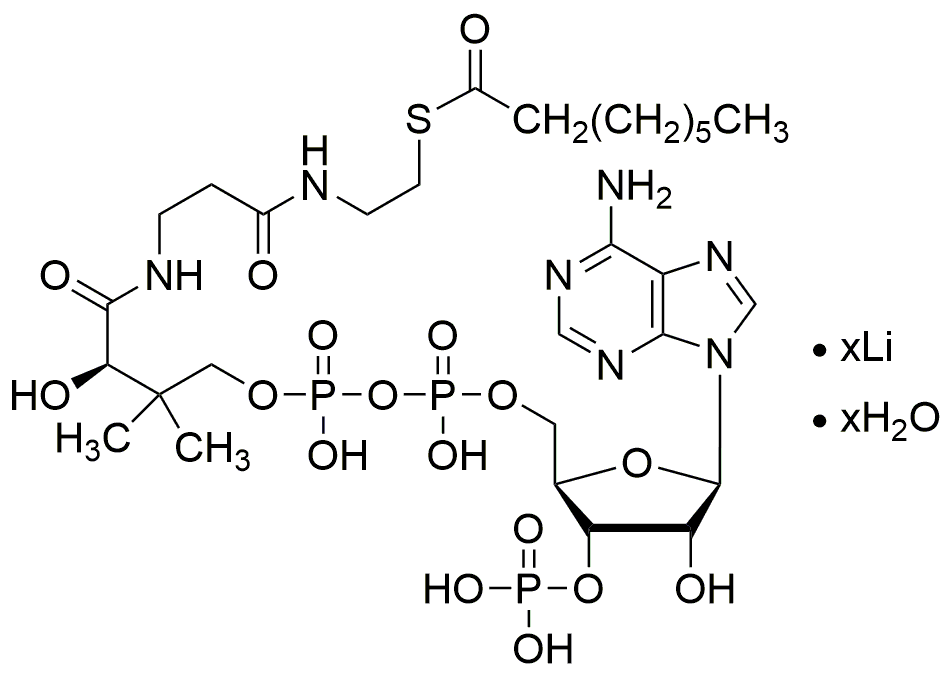Octanoyl coenzyme A lithium salt hydrate is widely utilized in research focused on:
- Metabolic Studies: This compound plays a crucial role in fatty acid metabolism, allowing researchers to study energy production and lipid synthesis in various biological systems.
- Biochemical Pathway Analysis: It serves as a key intermediate in metabolic pathways, enabling scientists to investigate the biochemical processes involved in cellular functions and disease mechanisms.
- Drug Development: The compound is used in the formulation of pharmaceuticals targeting metabolic disorders, providing a foundation for developing new therapeutic strategies.
- Food Industry Applications: It can be explored for its potential in enhancing flavor profiles and nutritional value in food products, appealing to health-conscious consumers.
- Cosmetic Formulations: The compound's properties make it suitable for use in skincare products, where it can aid in skin hydration and nourishment, attracting the attention of cosmetic formulators.
Información general
Propiedades
Seguridad y normativas
Aplicaciones
Octanoyl coenzyme A lithium salt hydrate is widely utilized in research focused on:
- Metabolic Studies: This compound plays a crucial role in fatty acid metabolism, allowing researchers to study energy production and lipid synthesis in various biological systems.
- Biochemical Pathway Analysis: It serves as a key intermediate in metabolic pathways, enabling scientists to investigate the biochemical processes involved in cellular functions and disease mechanisms.
- Drug Development: The compound is used in the formulation of pharmaceuticals targeting metabolic disorders, providing a foundation for developing new therapeutic strategies.
- Food Industry Applications: It can be explored for its potential in enhancing flavor profiles and nutritional value in food products, appealing to health-conscious consumers.
- Cosmetic Formulations: The compound's properties make it suitable for use in skincare products, where it can aid in skin hydration and nourishment, attracting the attention of cosmetic formulators.
Documentos
Hojas de datos de seguridad (HDS)
La SDS proporciona información de seguridad completa sobre la manipulación, el almacenamiento y la eliminación del producto.
Especificación del producto (PS)
La PS proporciona un desglose completo de las propiedades del producto, incluida la composición química, el estado físico, la pureza y los requisitos de almacenamiento. También detalla los rangos de calidad aceptables y las aplicaciones previstas del producto.
Certificados de análisis (COA)
Busque certificados de análisis (COA) ingresando el número de lote del producto. Los números de lote y de partida se pueden encontrar en la etiqueta de un producto después de las palabras "Lote" o "Lote".
Número de catálogo
Número de lote/lote
Certificados de origen (COO)
Este certificado de origen confirma el país en el que se fabricó el producto y también detalla los materiales y componentes utilizados en él y si se deriva de fuentes naturales, sintéticas u otras fuentes específicas. Este certificado puede ser necesario para cumplir con las normativas aduaneras, comerciales y regulatorias.
Número de catálogo
Número de lote/lote
Hojas de datos de seguridad (HDS)
La SDS proporciona información de seguridad completa sobre la manipulación, el almacenamiento y la eliminación del producto.
DownloadEspecificación del producto (PS)
La PS proporciona un desglose completo de las propiedades del producto, incluida la composición química, el estado físico, la pureza y los requisitos de almacenamiento. También detalla los rangos de calidad aceptables y las aplicaciones previstas del producto.
DownloadCertificados de análisis (COA)
Busque certificados de análisis (COA) ingresando el número de lote del producto. Los números de lote y de partida se pueden encontrar en la etiqueta de un producto después de las palabras "Lote" o "Lote".
Número de catálogo
Número de lote/lote
Certificados de origen (COO)
Este certificado de origen confirma el país en el que se fabricó el producto y también detalla los materiales y componentes utilizados en él y si se deriva de fuentes naturales, sintéticas u otras fuentes específicas. Este certificado puede ser necesario para cumplir con las normativas aduaneras, comerciales y regulatorias.


